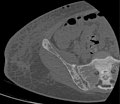Renal osteodystrophy

Editor-In-Chief: Prab R Tumpati, MD
Obesity, Sleep & Internal medicine
Founder, WikiMD Wellnesspedia &
W8MD medical weight loss NYC and sleep center NYC
| Renal osteodystrophy | |
|---|---|

| |
| Synonyms | |
| Pronounce | N/A |
| Specialty | N/A |
| Symptoms | Bone pain, skeletal deformities, fractures |
| Complications | Fracture, vascular calcification |
| Onset | |
| Duration | |
| Types | |
| Causes | Chronic kidney disease, secondary hyperparathyroidism |
| Risks | |
| Diagnosis | Blood test, X-ray, bone biopsy |
| Differential diagnosis | Osteoporosis, osteomalacia |
| Prevention | |
| Treatment | Phosphate binders, vitamin D analogs, parathyroidectomy |
| Medication | |
| Prognosis | |
| Frequency | Common in patients with chronic kidney disease |
| Deaths | |
Renal osteodystrophy is a bone disease that occurs when your kidneys fail to maintain the proper levels of calcium and phosphorus in your blood. It's a common problem in people with kidney disease and affects almost all patients at some stage of chronic kidney disease.
Causes[edit]
Renal osteodystrophy is caused by changes in the hormones that maintain calcium and phosphorus balance. The kidneys convert vitamin D from the skin and diet into an active form that helps the body absorb calcium from the intestines. In kidney disease, this conversion is reduced, leading to lower calcium levels. In response, the parathyroid glands produce more parathyroid hormone (PTH), which helps restore calcium levels by reabsorption from the bones. However, this can lead to bone disease.
Symptoms[edit]
Symptoms of renal osteodystrophy can vary. Some people have no symptoms, while others may experience bone pain, joint pain, fractures, and muscle weakness. In children, the disease can cause growth retardation and bone deformities.
Diagnosis[edit]
Diagnosis of renal osteodystrophy involves blood tests to measure levels of calcium, phosphorus, PTH, and vitamin D. Bone biopsy may also be performed to assess the type and severity of the disease.
Treatment[edit]
Treatment aims to restore the balance of calcium, phosphorus, and PTH. This may involve dietary changes, medications to lower phosphorus levels, vitamin D supplements, and in some cases, surgery to remove the parathyroid glands.
Gallery[edit]
-
Renal osteodystrophy
-
Renal osteodystrophy
-
Renal osteodystrophy
-
Renal osteodystrophy
-
Renal osteodystrophy
-
Renal osteodystrophy
See also[edit]
References[edit]
<references />
Ad. Transform your life with W8MD's Budget GLP-1 injections from $75


W8MD offers a medical weight loss program to lose weight in Philadelphia. Our physician-supervised medical weight loss provides:
- Weight loss injections in NYC (generic and brand names):
- Zepbound / Mounjaro, Wegovy / Ozempic, Saxenda
- Most insurances accepted or discounted self-pay rates. We will obtain insurance prior authorizations if needed.
- Generic GLP1 weight loss injections from $75 for the starting dose.
- Also offer prescription weight loss medications including Phentermine, Qsymia, Diethylpropion, Contrave etc.
NYC weight loss doctor appointmentsNYC weight loss doctor appointments
Start your NYC weight loss journey today at our NYC medical weight loss and Philadelphia medical weight loss clinics.
- Call 718-946-5500 to lose weight in NYC or for medical weight loss in Philadelphia 215-676-2334.
- Tags:NYC medical weight loss, Philadelphia lose weight Zepbound NYC, Budget GLP1 weight loss injections, Wegovy Philadelphia, Wegovy NYC, Philadelphia medical weight loss, Brookly weight loss and Wegovy NYC
|
WikiMD's Wellness Encyclopedia |
| Let Food Be Thy Medicine Medicine Thy Food - Hippocrates |
Medical Disclaimer: WikiMD is not a substitute for professional medical advice. The information on WikiMD is provided as an information resource only, may be incorrect, outdated or misleading, and is not to be used or relied on for any diagnostic or treatment purposes. Please consult your health care provider before making any healthcare decisions or for guidance about a specific medical condition. WikiMD expressly disclaims responsibility, and shall have no liability, for any damages, loss, injury, or liability whatsoever suffered as a result of your reliance on the information contained in this site. By visiting this site you agree to the foregoing terms and conditions, which may from time to time be changed or supplemented by WikiMD. If you do not agree to the foregoing terms and conditions, you should not enter or use this site. See full disclaimer.
Credits:Most images are courtesy of Wikimedia commons, and templates, categories Wikipedia, licensed under CC BY SA or similar.
Translate this page: - East Asian
中文,
日本,
한국어,
South Asian
हिन्दी,
தமிழ்,
తెలుగు,
Urdu,
ಕನ್ನಡ,
Southeast Asian
Indonesian,
Vietnamese,
Thai,
မြန်မာဘာသာ,
বাংলা
European
español,
Deutsch,
français,
Greek,
português do Brasil,
polski,
română,
русский,
Nederlands,
norsk,
svenska,
suomi,
Italian
Middle Eastern & African
عربى,
Turkish,
Persian,
Hebrew,
Afrikaans,
isiZulu,
Kiswahili,
Other
Bulgarian,
Hungarian,
Czech,
Swedish,
മലയാളം,
मराठी,
ਪੰਜਾਬੀ,
ગુજરાતી,
Portuguese,
Ukrainian








